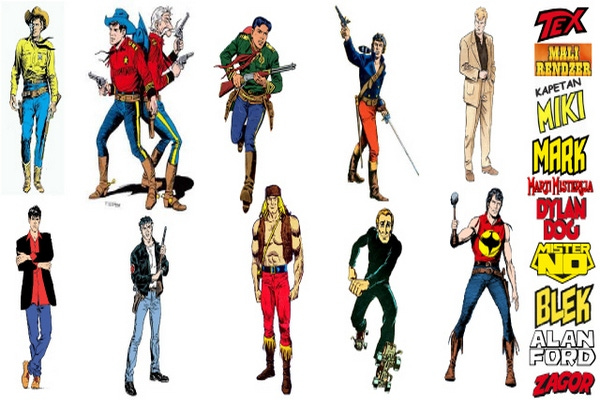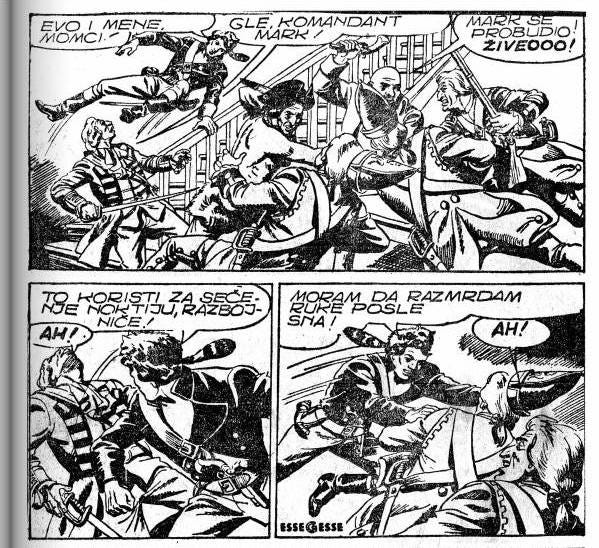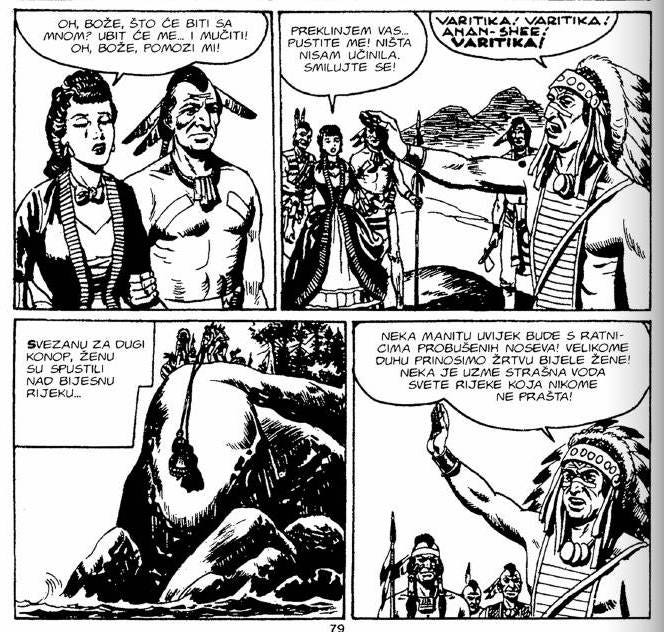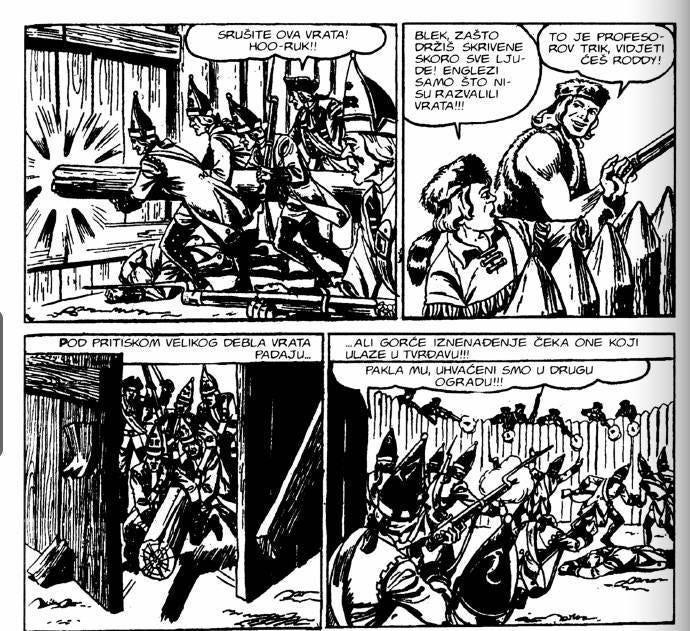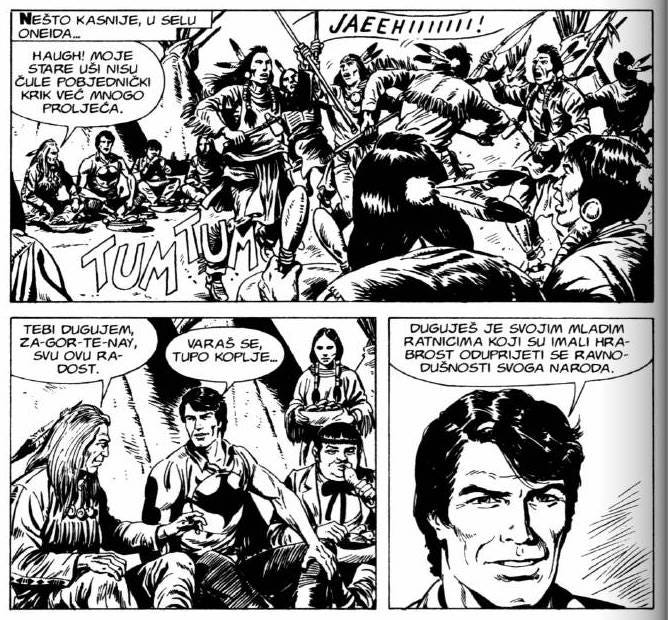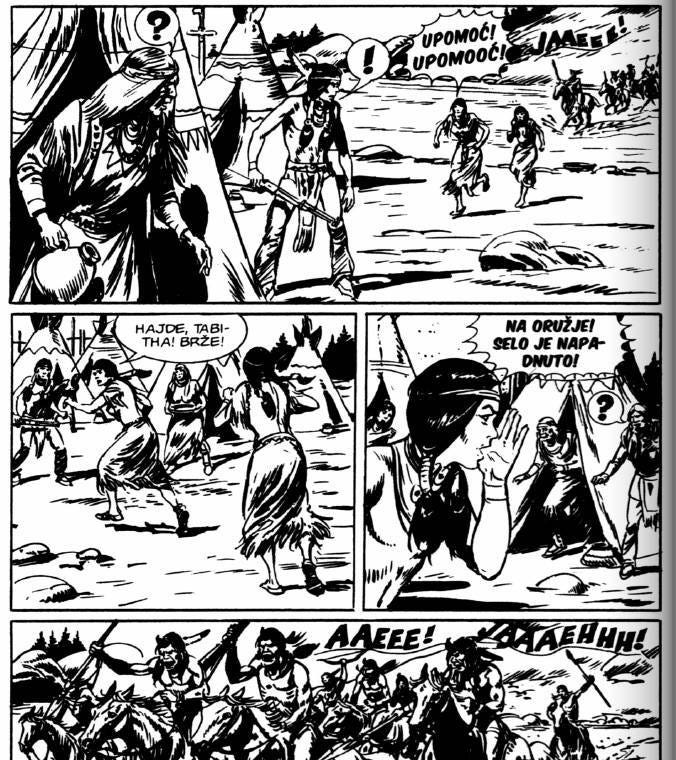The weird and wonderful Canada of Italian comic books
When they can be bothered to notice it, that is
European popular culture, especially on the eastern side of the continent (regular readers will recall my recurring interest in this topic) is full of weird and fascinating takes on North American history. German obsession with Native tribes of North America has been well documented, and both West and East Germany had a booming film industry in westerns during the Cold War. On the DDR side the genre was called, because that’s who the films centered, the Indianerfilme.
Much less is known about the many Italian comic books set in North America from the early 1700s onward. Sure, people have heard of the spaghetti westerns, but few will know of the fumetti, which capture kids’ imaginations before they’re old enough to watch westerns at the movies. For some reason, the North American comics heroes with which at least two generations of Yugoslavian children grew up chiefly came from the translations of the Sergio Bonelli Editore comics. Why would we get Wild West comics from Italy? Boh. I think we all presumed these characters came from some American franchise. Few bothered reading the masthead.
And it’s a vast empire these Italian comics, let me tell you. The company is still around and still doing well, STILL publishing the characters created when I was a child in the 1970s and some going back to the 1940s. I spent my Sunday trawling this massive forum where South Slavs trade the hi res files of comic books of their youth. The history of North America that many of those comic books offer is hilariously inaccurate, but I’ve noticed a growing sophistication over time in at least one or two of the series, and the newer and more elaborate the books, the smarter they will be about history.
COMMANDANTE MARK
“Komandant Mark”, as the cartoon was known in YU, turns out is one of the silliest. The era is some time before the American independence. Mark is the leader of a group of rebels against the English who call themselves the Wolves of Ontario. What is Ontario? Ontario is a fortress that they turned into their HQ. It’s somewhere near the Great Lakes? That, like many other matters, is fuzzy. Messengers from Boston reach it sometimes for ex so it can’t be that far from the east coast. Mark is dressed somewhere in the vicinity of Davy Crockett.
The baddies are THE ENGLISH. They are always dressed impractically and pompously and wear for some reason the hats that are a little bit on the klanish side. They’re referred to as the Redcoats. They’re older than the rebels, tend to have uglier faces, the odd eye patch.
Their muskets stand no chance against Mark’s… fists.
Mark has two sidekicks, one of whom is a wise “Indian”, the Sad Owl. But generally Indian tribes are not to be trusted because — are you ready — the English bribe them to fight on their side against the American rebels. In the book The Wolves of Ontario, the Wolves fight against the tribe called the “Pekotas”.
By the way, one of the recurring tropes in many of the comic is the “Indian torture dance”, an almost mandatory scene in which a captive is tied to a mast and forced to watch the collective dance which is supposed to culminate in his/her torture. Few however do culminate that way of course because the captive is rescued by the hero and his entourage before anything gory can happen.
If you can ignore the copy, the artwork is often quite decent and obviously informed by wartime painting.
IL GRANDE BLEK
Black the Rock I found more interesting, but I think he had a shorter run than Mark. (The trio of creators known as EsseGesse created both.) According to some sources he is of French origin, so hey — the French do exist in NA in this one. The story is roughly the same: he is the leader of the trapper community that has its own chunk of territory (hell if I know. Maybe the EsseGesse lads heard of the coureurs de bois and improvised?) and rebels against the tedious English. Gl’Inglesi still wear highly impractical and very red clothes. The “Indians” still have bizarre practices and taboos that are created to aid the plot, like fearing the river but willing to hang a woman in it from a great height in some sort of intimidation technique.
But some history was actually read for this one. The tribes form strategic alliances (mostly with the English and the French) and are often divided among themselves. The chiefs and warriors and the odd woman are sometimes fully formed characters. The tribe names are roughly accurate-ish. (One of the books that I managed to read is called The Drums of the Iroquois or Bubnjevi Irokeza, in South Slav languages.)
“Canada” exists but what they mean is La Nouvelle France since it’s a completely French Canada, permanently of the period before the Seven Years War, and since the French also fight the English in endless skirmishes, just like the ahem rebel proto-American trappers, the trappers and the French form alliances. The English hold the fortress called Kingston! on a river called the Lawrenrod.
In the book Canada in Flames, Blek and his sidekicks go to Canada to specifically aid its French population against the incursions of the English, and things get complicated already in the first walk through the forest. Blek himself temporarily ends up on the torture pole of the Senecas.
Ever the Keystone Cops, the English get into the trap at the French fortress Larousse.
There are visits in disguise to the English aristocratic “governors”, the shady taverns, the canoe chases, and friendly knife duels between Blek and an “Indian” warrior celebrity, and there are damsels in distress, and stubborn damsels who got it into their heads to be adventurous. And I realized I could read this stuff without much tut-tutting, in all honesty.
Zagor
This is another Bonelli, and one of the longest lasting ones. Zagor was always one of THE most popular when I was growing up and no wonder it’s still being published today. They’ve honed it. I’ve only dipped into a couple of books, but liked that I saw. Zagor himself is a “mixed blood” character, at least by adoption if memory serves. While the thing is happening “in the Prairies”, his sidekick is, incongruously, a Mexican (and, more congruously, therefore also likely mixed race). I think with Zagor we’re well in to the ripe 19th century, but the US nation state is not yet cooked. In one of the books, Zagor helps a tribe track down a group of settlers that’s been selling them highly addictive alcohol in order to control them. It’s a sort of the Sacklers-but-armed situation; it comes to war; Zagor helps the tribe win it decisively.
In the subsequent book in the series, Chico takes up painting and ends up bringing home to Darkwood and Zagor a painting of an unknown tribe he came across in his rambles. Zagor is surprised to see the hostile tribe of the “Skids” so close to the territory of the peaceful Chayennes whose male population have left the women and the elderly behind and gone hunting. There’s some beautiful artwork for a few pages involving the herd of bison and the carving of a dead buffalo, but everything leads up to the dramatic pages of the inter-tribal warfare.
I got caught up in the story so much that I didn’t look for the books with potential CanCon. There must be some surely, in those “Prairies”. But with Zagor too I’ve noticed more effort to read the history, anthropology, keep up with the newer information. It’s the fantasy of the Wild West preserved in aspic, that’s also, within that aspic, in some way, evolving. That’s how mythologies live on, I suppose. It is a mythology of sorts, but much less alive in North America itself than in the world of the European comic books. And it’s quite possible that it dovetails with something local — maybe Il Commandante Mark is an Italian fighting the Austrian and French occupation of his country that’s not yet a nation? I’m sure the post-WW2 Yugoslavs found some of the us vs. the Axis occupiers in these comic books set in the far away America.



